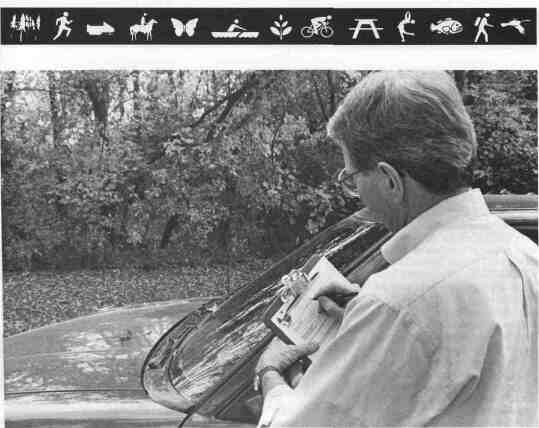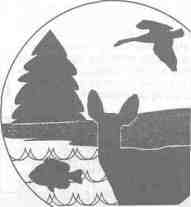Our Natural Resources Being Resourceful by Anne Mueller
A new volunteer program is designed to make
natural resources our future as well as our
heritage Wanted: Conservationists. Must regularly monitor local geographical area and report signs of resource violations and environmental changes. Also should be willing to periodically capture and band waterfowl, conduct creel surveys of anglers, test stream quality, and trap and transplant wild turkeys. Remuneration: Making positive contribution to natural resources and personally observing the results. To apply, contact your local Conservation Police Officer or call (217) 782-6431. Classified ads like this have not appeared in newspapers, but yet a program called Resource Watch has recruited more than 200 volunteers since its formation was announced six months ago. Its participants are changing the way natural resources are being monitored in Illinois. And project coordinators say no other state has established a program that's as broad. Resource Watch is a collaboration between the Department of Natural Resources and the Conservation Police Lodge of the Fraternal Order of Police. Conservation Police Officer Glenn Sanders, who also serves as the Lodge's vice president, says the volunteers have become "the extra eyes" of CPOs. The officers' services are stretched, he says, because they patrol areas up to 800 square miles in size. "With 109 CPOs in the field, and the state being as big as it is, there's no way that we can see everything we need to see out there," Sanders said. "The Lodge wanted to sponsor a program like this, one that would show a positive benefit for wildlife." DNR had previously established a Volunteer Network of park naturalists/interpreters, campground hosts, prairie preservationists and other resource workers following a recommendation from Conservation Congress, a grassroots assembly of outdoor recreationists and Conservationists. However, a law enforcement component to the volunteer network was lacking until suggested by a frequent visitor to Sangchris Lake State Park, Gene Manning of rural Pawnee. The father of Natural Resources Director Brent Manning, he mentioned to his son that the Department could bolster conservation efforts by looking to park visitors and retired individuals like himself. "I think anyone who's interested in wildlife would be willing to help," Gene Manning said. Out of his suggestion came Re- 40 * lllinois Parks & Recreation * November/December 1996 
By filling out a one-page survey log twice a month, Resource Watch volunteers help Conservation Police Officers keep tabs on environmental changes and suspected resource violations. Some 250 volunteers have selected areas to monitor since the program began this summer. source Watch. Sanders stresses that law enforcement efforts are a small percentage of the work Resource Watch volunteers are asked to do. The emphasis is on participating in "hands on" resource management programs, including banding Canada geese, installing waterfowl nesting structures, assisting at urban fishing clinics and participating in bird counts. "Resource jobs, such as counting wildlife or recording roadkills, are the backbone of the program and are really what Resource Watch is all about," Sanders said. So far about 30 CPOs are trained as Resource Watch coordinators, whose responsibilities include arranging with volunteers in their region to work on DNR projects that need assistance. One volunteer team might concentrate on building wood duck boxes, for example, while another is involved in helping biologists with fish fin clipping at a local hatchery. Sanders says there's a lot of flexibility in the types of projects that are undertaken. "We're letting local needs and concerns determine what's done," he said. Although resource projects vary statewide, one aspect of the program is constant. Each volunteer "adopts" an area of his or her choosing for environmental protection. Most drive their routes, but some anglers have adopted waterways they routinely fish and conduct their patrols by boat. Resource Watch participants look for environmental threats such as illegal timber cutting poaching, open dumping, or stream or wetland alterations. By monitoring their area at least twice a month and submitting a written form to their Resource Watch coordinators, volunteers Illinois Parks & Recreation * November/December 1996 * 41 
can alert officers to resource violations or other changes that may be a biological or management concern. Sanders says fast field work by one volunteer led officers to determine within hours the source of a fish kill and prevented damage from spreading further downstream. In other instances, local CPOs have issued citations for hunting and fishing violations as a direct result of information supplied by Resource Watch volunteers. The volunteers are instructed to observe and make notes, but to not confront suspected violators themselves. They are told to never put themselves in a situation where their personal safety or the safety of others is jeopardized. Sanders says stakeouts or other situations requiring professional police training are not a part a volunteer's job description. "We're not looking for junior game wardens," Sanders said. Instead, when volunteers make their rounds and suspect natural resource violations are taking place, they're told to use a Resource Watch checklist to take notes of what they see. Checklist items include a physical description of each suspect, descriptions and license numbers from any vehicles in the area, the time the suspected violation occurred, the type of activity involved (such as unlawful timber cutting or hunting out of season), and the types of firearms, bow and arrow devices, or other equipment observed. If a suspicious activity is in progress, Resource Watchers are told to immediately report it on the Target Illinois Poachers hotline at 1-800-252-0163. Volunteers can obtain much information by driving by the incident scene once and remembering what they see. Officers stress it is more important that information be reported quickly, even if a volunteer is able to give only partial information. If a violation has already occurred, volunteers need to make a judgment call: Should an officer investigate the scene immediately because critical evidence might be destroyed, or can the incident be reported by mail and handled as a follow-up type of investigation? As an example, coordinators say if evidence of a poached animal is found, it's more than likely it can be investigated through a follow-up procedure. Some volunteers opt to take a camera or a video cassette recorder on their survey routes, but are told to photograph suspected violators only when they're sure they can obtain pictures without being seen. Even if they see no illegal activity, Resource Watchers may want their camera to photograph wildlife they might see. And that's another aspect of the program that appeals to volunteers—the chance to get out and observe nature. In the Resource Watch survey log they file twice a month, volunteers list any unusual live wildlife sightings they've witnessed. Seeing an endangered species like a river otter or a snowy egret is a perk to volunteers—and beneficial information to biologists. Volunteer service coordinator Noel Laurent says applicants see the Resource Watch program as a way to contribute positively to the outdoors. "On their applications, many will write something like 'I love the outdoors and I want to see it preserved,'" she said. "There's a real sense of wanting to be an active steward." Sanders says that Resource Watch volunteers represent all kinds of outdoor enthusiasts, from hikers to hunters, from retired individuals to college students. Sanders estimates 25 percent of volunteers are women. "We're just looking," Sanders said, "for people who have a good feeling about conservation and want to help. Anne Mueller is a staff writer for Outdoor Illinois.
Here's how you can become a Resource Watch volunteer For a Resource Watch application or additional information, contact the DNR Office of Law Enforcement, 524 S. Second St., Springfield, Ill 62701-1787, or call (217) 782-6431. 42 * Illinois Parks & Recreation * November/December 1996 
Governor Dedicates Five New Illinois
Nature Preserves Additions include the Faulkner-Franke Pioneer Railroad Prairie Nature Preserve in Jackson County, the Bourbonnais Geological Area Nature Preserve in Kankakee County, Toadwood Scrubs as buffer to the E. Dora Bohm Memorial Nature Preserve in Madison County, and, in Will County, expansion at Thorn Creek Woods Nature Preserve and establishment of Goodenow Grove Nature Preserve. "I consider these properties to be excellent additions to the nature preserve system, and I am delighted that they will be protected for the enjoyment of future generations," the Governor said. Dedication of a nature preserve is a legal process in which the owner voluntarily restricts future uses of the area to ensure that it remains in its natural state. "Although the owners retain ownership and custody of their land, they relinquish their right to develop the areas," Natural Resources director Brent Manning said. "A property's dedication as a nature preserve provides permanent protection, even if a property is conveyed to another party at some future date. It also protects an area from being taken under eminent domain by state or municipal authorities." A nature preserve may be used for educational purposes, scientific research and aesthetic enjoyment. Nature preserves are dedicated with the approval of the nine-member Illinois Nature Preserves Commission, the director of the Department of Natural Resources and the Governor.
$6.4 Million in Improvements
Planned at Site M "The improvements planned at Site M represent an investment in our future and demonstrate our commitment to the natural resources of this state," the Governor said. "From major road improvements and lake construction to trail development and stream bank stabilization, we'll be demonstrating state-of-the-art resources protection and providing a wide range of recreational opportunities for the people of Illinois." The Department of Natural Resources will devote $2.7 million to road projects. Those will include initial construction work on a scenic drive through the interior of Site M, including a scenic overlook of the Panther Creek valley; improvements to Cox and Watkins roads, and resurfacing of the Newmansville Road from Illinois Route 125 to the entrance of Site M. DNR also will provide matching funds for a bridge replacement on Herrman Road. The department will spend $2.5 million to design and begin building a 210-acre lake, along with boat and road access improvements. About $1 million will be used to build 16 miles of multi-purpose trail, including pedestrian bridges. That will add to a nine-mile loop built this year. Included in that amount is funding to complete an equestrian campgrounds, including the addition of water and sanitary facilities, tables, grills and other improvements. More than $200,000 in income from farm leases in Site M will be used to complete a 25-acre lake and picnic area in Gridley Road at the south end of Site M, develop several picnic areas at existing pond sites and add informational signs, including two major entrance signs. DNR is working with the Natural Resource Conservation Service on construction of erosion control structures in the 15,574-acre site. The department also will work with the Department of Agriculture to reduce stream bank erosion along Panther and Cox creeks through plantings and other measures. The Site M improvements were outlined in a master plan approved in April.
"From major road improvements and
lake construction to trail development
and stream bank stabilization, we'll
be demonstrating state-of-the-art resources
protection and providing a
wide range of recreational
opportunities for the people of Illinois."
— Governor Jim Edgar Illinois Parks & Recreation * November/December 1996 * 43 
Edgar Signs Bill Creating License Plate to Benefit Wildlife Prairie Park Governor Jim Edgar signed legislation Friday, August 9, creating new, specialized license plates for Illinoisans who want to support the development of wildlife habitat in Illinois and Wildlife Prairie Park near Peoria. The bill signing took place at Conservation World during the Illinois State Fair. The legislation creates the Wildlife Prairie Park license plate. Persons purchasing the special plates will pay an additional $40 for the original plate and renewal fees of $27, of which $25 would go to the Wildlife Prairie Park for improvements and maintenance. The legislation also creates a Sportsmen Series license plate with a similar fee structure to provide additional funding to the Department of Natural Resources to acquire, develop and manage wildlife habitat. Joining the Governor for the bill signing were Lt. Gov. Bob Kustra, who spearheaded efforts to explore options for the future of Wildlife Prairie Parks, and William Rutherford, former director of the Department of Conservation, who founded the 2,000-acre park in 1978. The park attracts more than 250,000 visitors annually and operates with an annual deficit of about $300,000. Rutherford, 81, has offered the park to the state. Chief sponsors of the legislation, which is effective Jan. 1, were Reps. Larry Wennlund (R-New Lenox), Joel Brunsvold (D-Milan), Larry Wollard (D-Carterville), Duane Noland (R-Blue Mound) and Mike Bost (R-Murphysboro), and Sens. Carl Hawkinson (R-Galesburg), Robert Madigan (R-Lincoln), Harry "Babe" Woodyard (R-Chrisman), Jim Rea (D-Christopher) and James "Pate" Philip (R-Wood Dale.)
Fundraisers Net $38,000 for Conservation Foundation The Foundation's Lake Michigan Fishing Tournament raised $20,000 for the Department's programs, including the Urban Fishing Program. The Second Annual Golf Outing at Panther Creek, Springfield, attracted 134 golfers and generated $18,000 for the Department's youth programs. To date, the Foundation has been successful in raising more than $600,000.
Deer Hunt Set at Rock Cut State Park for Hunters with Disabilities "This hunt underscores the Department's continued dedication to providing opportunities for individuals with disabilities to participate in our programs," director Brent Manning said. Forty hunters with disabilities will be eligible to participate in one of the three-day segments of the hunt. Depending on hunter preference and availability, selected individuals will be assigned to either the November or the December portion of the hunt Permits to hunt deer at Rock Cut State Park will be issued at the park check station on the day of the hunt. These permits will be issued in addition to any other permits the hunter may possess. There will be a $15 fee for all permits. Each hunter with a disability may be accompanied by a non-disabled partner. They may bring a partner with them, or a partner will be provided if requested. If the partner wishes to hunt, they will also be required to purchase a $15 permit at the site. Permit applications may be obtained by contacting the Region I office at (815) 625-2968, 2612 Locust St., Sterling, Ill. 61081 and must be completed by October 18 for the 1996 hunt. 44 * Illinois Parks & Recreation * November/December 1996 |
||||||||||||||


